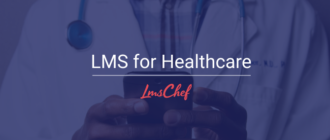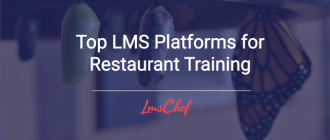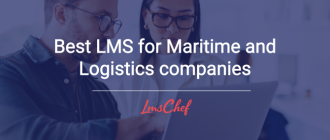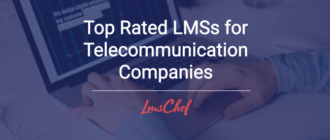This ultimate guide covers everything you need to know about finding the best learning management system for nonprofits.
Budget restraints, dispersed teams, resource shortages… nonprofit organizations face a number of challenges when it comes to training. Fortunately, a high-powered learning management system (LMS) can solve many of those training pain points.
An LMS can automate training processes, speed up onboarding, and free up valuable resources. It’s also a powerful tool for boosting employee and volunteer engagement. But to reap these benefits, you need to choose the best platform for the task. So, without further ado, let’s dive into the benefits, key features, and our top five nonprofit LMS solutions.
Benefits of Using a Learning Management System for Nonprofits
The right learning management system can empower your nonprofit organization, enabling you to provide comprehensive training and even monetize education programs. But that’s not all. Here are the key benefits of using an LMS for NGOs.
Cut training costs:
It goes without saying that nonprofits have limited budgets. As such, they’re always on the lookout for ways to reduce costs without sacrificing quality. An LMS system can help with this. By moving training online, NGOs can cut costs associated with on-site training. These include travel, venue, and instructor fees.
Free up resources:
Deploying training via an LMS (or opting for a blended learning model) can reduce time-consuming routines. A robust learning management software allows you to automate training management tasks (enrollment, reminders, etc.). As a result, nonprofit teams free up time to concentrate on more impactful work. This creates more resources and reduces labor costs.
Reduce training time:
Another thing that nonprofits (and every other organization, for that matter) are short on is time. By giving staff, volunteers, and members the option to train online at their own speed, you create a more efficient training process. Plus, you don’t have to organize on-site training sessions and coordinate different schedules.
Improve accessibility:
Many LMSs come with mobile learning apps so that trainees can access training content anytime and anywhere. This reduces learning curves and ensures that learners receive all the information at the point of need.
Make training consistent:
Many nonprofit organizations have a dispersed workforce, with employees and volunteers across different time zones and locations. This can lead to inconsistencies in the training. Using an LMS is a great way to standardize training. Since all learners will have access to the same content, you can create a more homogenous training experience.
Boost employee and volunteer engagement:
Volunteers, members, and donors are the lifeblood of NGOs. As such, keeping engagement high is a major goal. With a nonprofit LMS, you can build an interactive community. Learners can participate in discussion boards or forums, share comments, and receive updates on virtual bulletin boards.
Monetize training courses:
Most nonprofit organizations create training materials in-house. And this could also become another channel of income. Best nonprofit LMS platforms offer white labeling, which allows organizations to brand the platform. That means your organization can sell training courses to the public to earn extra revenue, raise awareness, and educate a wider audience.
Key Features for a Nonprofit LMS
As the number of LMS offerings continues to grow, it’s becoming trickier for buyers to choose the right one for their needs. You can pick the LMS with all the bells and whistles under the sun. But, if it doesn’t fulfill your needs, it’s a flop.
This is the case when choosing a learning management system for nonprofits. It has to offer capabilties that actually enhance your organization. To help you, here are the must-have features all learning management systems for nonprofits should have.
Essential LMS features for NGOs:
- User-friendly interface to ensure that all staff, volunteers, and members can easily navigate the platform.
- Mobile learning app so teams can access training from anywhere anytime.
- Automation features to reduce repetitive manual tasks, such as enrollments, email notifications, and grade checking.
- Customization tools like white-labeling and custom user roles so you can tailor the platform to your organization and its needs.
- Robust reporting capabilities to efficiently monitor training impact.
- Security features to ensure you comply with relevant regulations if your organization deals with sensitive data.
Nice to have features for NGOs:
- Content authoring capabilities so you can build, manage, and edit training content in-house.
- Multi-lingual support to create a welcoming learning environment across diverse communities.
- Integrations with systems like CRMs, Zoom, fundraising software, and other databases.
- Offline learning if your organization operates in remote areas with limited internet access.
- Certification to reward volunteers, employees, and other stakeholders when they complete training modules.
5 Best Learning Management Systems for Nonprofits
Now let’s compare five of the best LMSs for non profits to help you make the best decision for your organization.
| LMS | Standout features | Best for |
|---|---|---|
| Blackboard LMS | – Robust ILT management tools – Extensive list of integrations – Assessment and auto-grading tools | – Holding instructor-led training sessions – Syncing your LMS with other systems – Streamlining assessments and assignment grading |
| Thinkific LMS | – eCommerce capabilities – In-built course authoring tool – Live hosting capabilities | – Monetizing training courses – Creating bespoke training courses – Holding live virtual events or workshops |
| iSpring Learn LMS | – Fully integrated authoring tool for creating HTML5 and SCORM courses – Intuitive interface and a quick setup that’s easy to configure -Mobile app with offline learning support | – Creating in-house training content for staff, volunteers, and partners – Rolling out quality eLearning courses quickly and with no previous experience – Providing accessible training at the point of need |
| Chamilo LMS | – Basic course authoring capabilities – Intuitive interface – Offers multi-lingual support | – Creating in-house training courses – Offering an accessible training experience – Tailoring the platform to different audiences |
| 360 Learning LMS | – Integrated course authoring suite – Collaborative learning tools, such as shared learning spaces – An array of ILT management tools | Building in-company training courses – Involving stakeholders, employees, and members in training – Running in-person or instructor-led training |
1. Blackboard
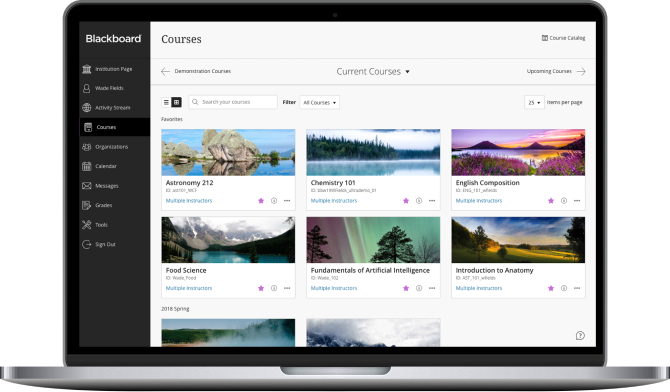
Blackboard is one of the leading LMS for nonprofits, thanks to its customization options. The platform has tools to customize user roles, automate training management tasks, and track learner progress. Plus, it constantly rolls out new features and enhancements.
Blackboard really shines when it comes to instructor-led training. The platform allows you to host virtual training sessions and live chats. Instructors can easily create and grade assessments and share the results. Moreover, the discussion boards help create a community even amongst dispersed teams.
Best for: Organizations that want to run classroom or VILT training sessions.
Pricing: Starting at $9,500/year.
2. Thinkific
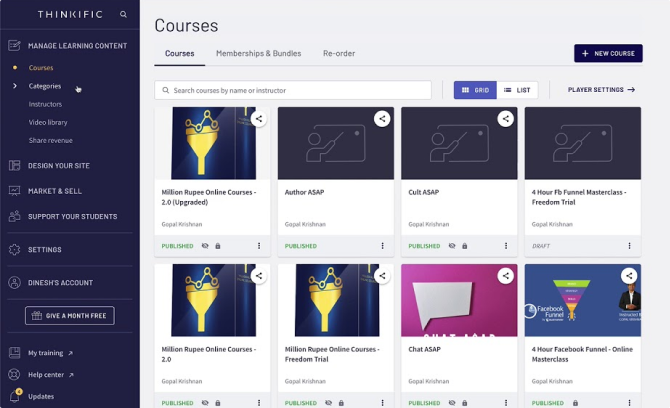
This is an ideal training solution for nonprofit organizations that want to combine the features of an LMS with a course marketplace. Thinkific enables organizations to build online training courses and host live Q&A sessions. And the platform offers metrics to help you monitor the revenue from each course. As such, it’s a stellar option for NGOs that want to hold regular workshops, sell courses for fundraising, and web host.
The LMS for nonprofits has in-depth reporting capabilities, certification, and tools to customize the platform. It also has an in-built course authoring tool. That way, organizations can build interactive training courses and quizzes within the platform, with no previous experience.
Best for: Organizations that want to monetize training courses and grow their online presence.
Pricing: Starting at $36/month (discounts available for NGOs).
3. iSpring Learn LMS
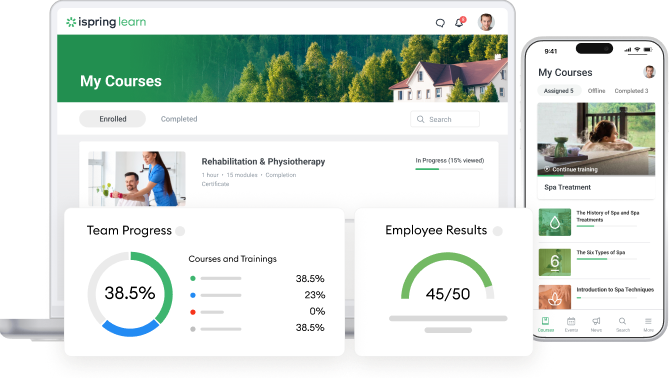
iSpring Learn LMS is simple to use and has robust customization tools with a 30-day free trial. For example, NGOs can segment learners into groups based on organizational structure and build separate learning tracks. It also integrates with leading systems, including video conferencing software like Zoom and MS Teams. As such, it’s an excellent choice for blended education programs.
iSpring Learn has robust reporting, multi-lingual support, and a slew of automation features to streamline onboarding and training. However, there are two standout features. It comes with an award-winning authoring tool so NGOs can create interactive courses in-house. The PowerPoint-based authoring tool is simple to use and packed with templates and a fully-stocked content library.
Secondly, the beautiful mobile app allows learners to download training content on their mobile devices and access it offline. This is a must for NGOs with volunteers in remote locations or areas without a steady internet connection.
Best for: NGOs that need to create in-house learning content and launch training quickly.
Pricing: Starting at $6.70 per monthly user (50 users).
4. Chamilo LMS
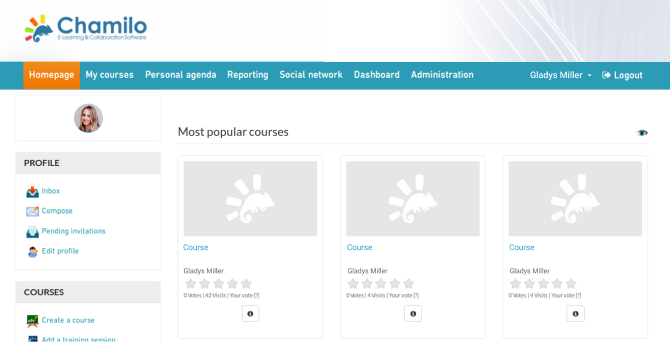
Chamilo is a free learning management system for nonprofits. As open-source software, it doesn’t have the same level of features and functionalities as other contenders on this list. Nevertheless, it still delivers many effective course management tools to manage online training. For instance, admins can organize virtual training sessions, segment users depending on their role, and generate progress reports.
When it comes to reporting, there are options to monitor learner progress, best scores, and time spent in sessions. As such, it provides a solid overview of training impact and user performance. Chamilo also offers course authoring capabilities so NGOs can build and deliver their own training modules.
Best for: Organizations looking for a free LMS for nonprofits with basic functionalities.
Pricing: An open-source version is available. Pricing for paid plans available upon request.
5. 360Learning
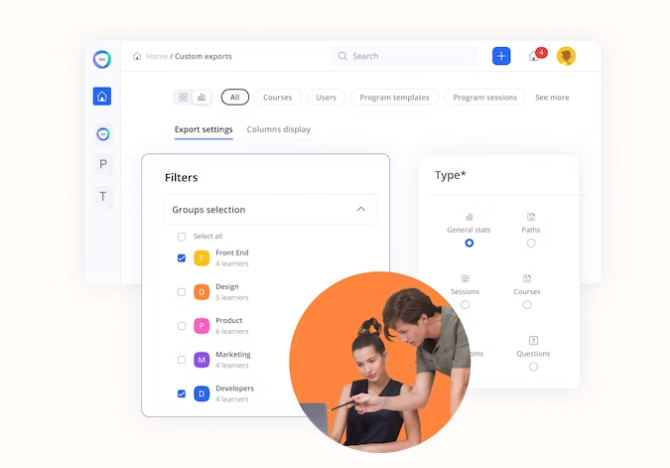
This learning platform focuses on collaborative training. That way, your organization can involve employees, volunteers, and other stakeholders in the training process. The LMS allows you to create shared learning spaces and hold feedback sessions to improve the learning experience.
360Learning also integrates with an authoring tool to build online courses and add interactive elements. These include videos, blog articles, images, and other relevant research documents. As such, it’s a good option for NGOs that need to build training from scratch.
The platform also offers custom reporting, extensive integrations with HR tools, and a mobile app. Finally, the Coaching feature is interesting, allowing learners to share their opinions within a course. This makes it great for collecting feedback.
Best for: NGOs looking to implement a collaborative learning experience or a coaching model.
Pricing: Starting from $8 per user/month.
Final Thoughts
NGOs have unique goals, challenges, and needs. As such, they need a learning platform that not only meets those needs but empowers their staff at the same time. Some key features to look for when choosing an LMS for this nonprofits include mobile learning, content authoring capabilities, robust reporting, and accessibility. And it goes without saying that affordable pricing plans are another big factor to consider.
With these core features, your organization can streamline training and engage learners. I hope this guide sheds some light on the learning management system for nonprofits.


